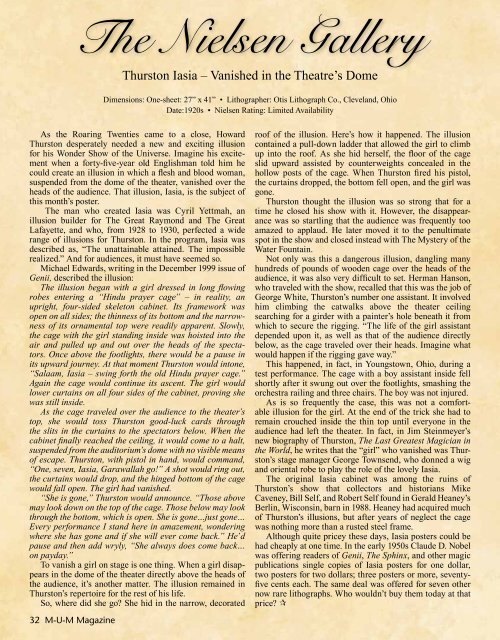(Hank) Moorehouse 1934 – 2011 - The Society of American Magicians
(Hank) Moorehouse 1934 – 2011 - The Society of American Magicians
(Hank) Moorehouse 1934 – 2011 - The Society of American Magicians
Create successful ePaper yourself
Turn your PDF publications into a flip-book with our unique Google optimized e-Paper software.
32 M-U-M Magazine<br />
<strong>The</strong> Nielsen Gallery<br />
Thurston Iasia <strong>–</strong> Vanished in the <strong>The</strong>atre’s Dome<br />
Dimensions: One-sheet: 27” x 41” • Lithographer: Otis Lithograph Co., Cleveland, Ohio<br />
Date:1920s • Nielsen Rating: Limited Availability<br />
As the Roaring Twenties came to a close, Howard<br />
Thurston desperately needed a new and exciting illusion<br />
for his Wonder Show <strong>of</strong> the Universe. Imagine his excitement<br />
when a forty-five-year old Englishman told him he<br />
could create an illusion in which a flesh and blood woman,<br />
suspended from the dome <strong>of</strong> the theater, vanished over the<br />
heads <strong>of</strong> the audience. That illusion, Iasia, is the subject <strong>of</strong><br />
this month’s poster.<br />
<strong>The</strong> man who created Iasia was Cyril Yettmah, an<br />
illusion builder for <strong>The</strong> Great Raymond and <strong>The</strong> Great<br />
Lafayette, and who, from 1928 to 1930, perfected a wide<br />
range <strong>of</strong> illusions for Thurston. In the program, Iasia was<br />
described as, “<strong>The</strong> unattainable attained. <strong>The</strong> impossible<br />
realized.” And for audiences, it must have seemed so.<br />
Michael Edwards, writing in the December 1999 issue <strong>of</strong><br />
Genii, described the illusion:<br />
<strong>The</strong> illusion began with a girl dressed in long flowing<br />
robes entering a “Hindu prayer cage” <strong>–</strong> in reality, an<br />
upright, four-sided skeleton cabinet. Its framework was<br />
open on all sides; the thinness <strong>of</strong> its bottom and the narrowness<br />
<strong>of</strong> its ornamental top were readily apparent. Slowly,<br />
the cage with the girl standing inside was hoisted into the<br />
air and pulled up and out over the heads <strong>of</strong> the spectators.<br />
Once above the footlights, there would be a pause in<br />
its upward journey. At that moment Thurston would intone,<br />
“Salaam, Iasia <strong>–</strong> swing forth the old Hindu prayer cage.”<br />
Again the cage would continue its ascent. <strong>The</strong> girl would<br />
lower curtains on all four sides <strong>of</strong> the cabinet, proving she<br />
was still inside.<br />
As the cage traveled over the audience to the theater’s<br />
top, she would toss Thurston good-luck cards through<br />
the slits in the curtains to the spectators below. When the<br />
cabinet finally reached the ceiling, it would come to a halt,<br />
suspended from the auditorium’s dome with no visible means<br />
<strong>of</strong> escape. Thurston, with pistol in hand, would command,<br />
“One, seven, Iasia, Garawallah go!” A shot would ring out,<br />
the curtains would drop, and the hinged bottom <strong>of</strong> the cage<br />
would fall open. <strong>The</strong> girl had vanished.<br />
“She is gone,” Thurston would announce. “Those above<br />
may look down on the top <strong>of</strong> the cage. Those below may look<br />
through the bottom, which is open. She is gone…just gone…<br />
Every performance I stand here in amazement, wondering<br />
where she has gone and if she will ever come back.” He’d<br />
pause and then add wryly, “She always does come back…<br />
on payday.”<br />
To vanish a girl on stage is one thing. When a girl disappears<br />
in the dome <strong>of</strong> the theater directly above the heads <strong>of</strong><br />
the audience, it’s another matter. <strong>The</strong> illusion remained in<br />
Thurston’s repertoire for the rest <strong>of</strong> his life.<br />
So, where did she go? She hid in the narrow, decorated<br />
ro<strong>of</strong> <strong>of</strong> the illusion. Here’s how it happened. <strong>The</strong> illusion<br />
contained a pull-down ladder that allowed the girl to climb<br />
up into the ro<strong>of</strong>. As she hid herself, the floor <strong>of</strong> the cage<br />
slid upward assisted by counterweights concealed in the<br />
hollow posts <strong>of</strong> the cage. When Thurston fired his pistol,<br />
the curtains dropped, the bottom fell open, and the girl was<br />
gone.<br />
Thurston thought the illusion was so strong that for a<br />
time he closed his show with it. However, the disappearance<br />
was so startling that the audience was frequently too<br />
amazed to applaud. He later moved it to the penultimate<br />
spot in the show and closed instead with <strong>The</strong> Mystery <strong>of</strong> the<br />
Water Fountain.<br />
Not only was this a dangerous illusion, dangling many<br />
hundreds <strong>of</strong> pounds <strong>of</strong> wooden cage over the heads <strong>of</strong> the<br />
audience, it was also very difficult to set. Herman Hanson,<br />
who traveled with the show, recalled that this was the job <strong>of</strong><br />
George White, Thurston’s number one assistant. It involved<br />
him climbing the catwalks above the theater ceiling<br />
searching for a girder with a painter’s hole beneath it from<br />
which to secure the rigging. “<strong>The</strong> life <strong>of</strong> the girl assistant<br />
depended upon it, as well as that <strong>of</strong> the audience directly<br />
below, as the cage traveled over their heads. Imagine what<br />
would happen if the rigging gave way.”<br />
This happened, in fact, in Youngstown, Ohio, during a<br />
test performance. <strong>The</strong> cage with a boy assistant inside fell<br />
shortly after it swung out over the footlights, smashing the<br />
orchestra railing and three chairs. <strong>The</strong> boy was not injured.<br />
As is so frequently the case, this was not a comfortable<br />
illusion for the girl. At the end <strong>of</strong> the trick she had to<br />
remain crouched inside the thin top until everyone in the<br />
audience had left the theater. In fact, in Jim Steinmeyer’s<br />
new biography <strong>of</strong> Thurston, <strong>The</strong> Last Greatest Magician in<br />
the World, he writes that the “girl” who vanished was Thurston’s<br />
stage manager George Townsend, who donned a wig<br />
and oriental robe to play the role <strong>of</strong> the lovely Iasia.<br />
<strong>The</strong> original Iasia cabinet was among the ruins <strong>of</strong><br />
Thurston’s show that collectors and historians Mike<br />
Caveney, Bill Self, and Robert Self found in Gerald Heaney’s<br />
Berlin, Wisconsin, barn in 1988. Heaney had acquired much<br />
<strong>of</strong> Thurston’s illusions, but after years <strong>of</strong> neglect the cage<br />
was nothing more than a rusted steel frame.<br />
Although quite pricey these days, Iasia posters could be<br />
had cheaply at one time. In the early 1950s Claude D. Nobel<br />
was <strong>of</strong>fering readers <strong>of</strong> Genii, <strong>The</strong> Sphinx, and other magic<br />
publications single copies <strong>of</strong> Iasia posters for one dollar,<br />
two posters for two dollars; three posters or more, seventyfive<br />
cents each. <strong>The</strong> same deal was <strong>of</strong>fered for seven other<br />
now rare lithographs. Who wouldn’t buy them today at that<br />
price? �



